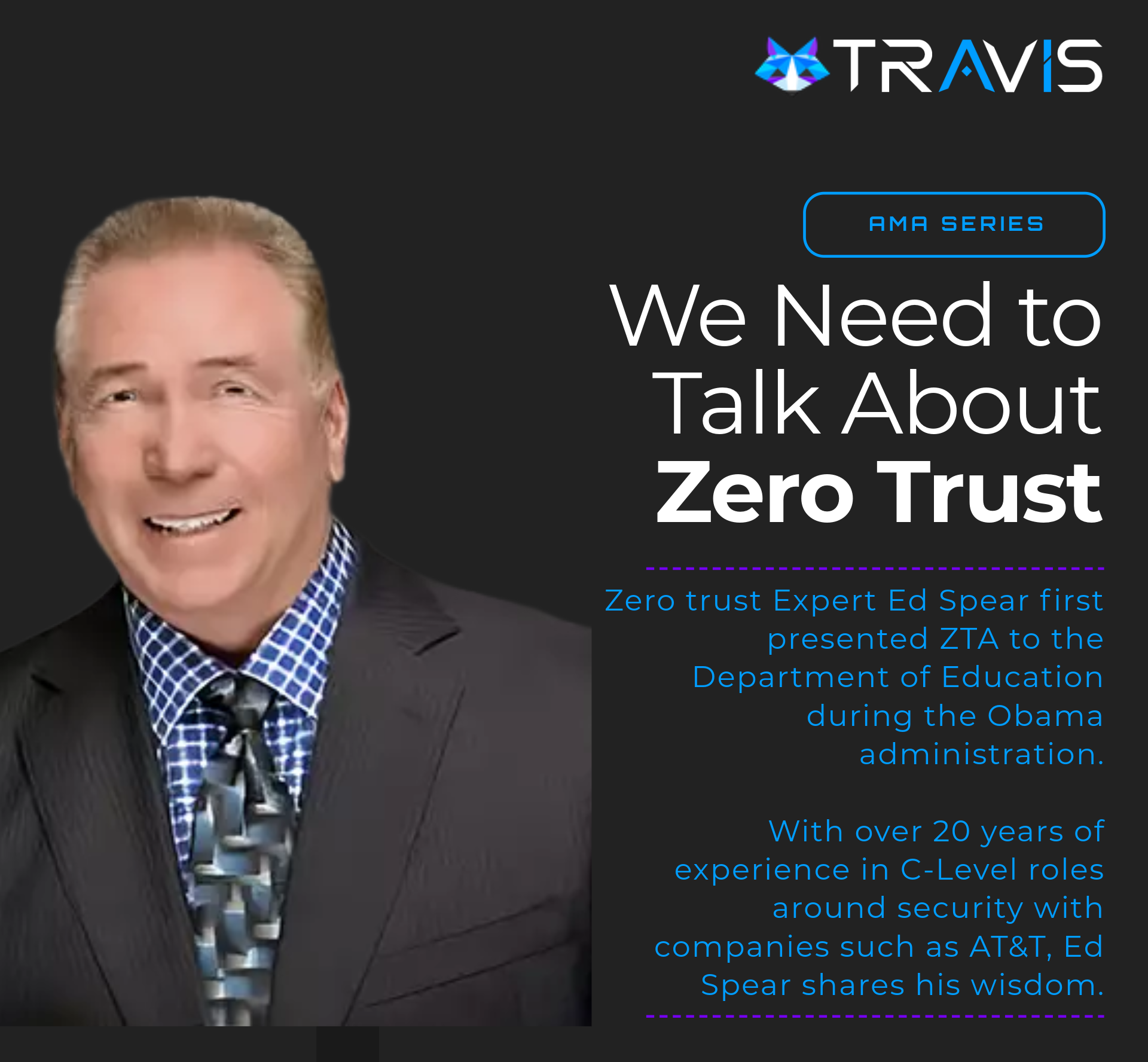Is your organization grappling with persistent cybersecurity challenges? You're not alone.
The threat landscape is more complex and costly than ever. The global average cost of a data breach reached $4.88 million in 2024, a significant increase underscoring the financial imperative to adopt more robust security models. Traditional security approaches often fall short in this environment. But there's a powerful approach that can alleviate many of these pain points: Zero Trust Architecture (ZTA).
.jpeg)
Zero Trust, as defined by the National Institute of Standards and Technology (NIST), is not a single product but a set of cybersecurity principles that shift defenses from static, network-based perimeters to focus on users, assets, and resources. The core mantra is "Never Trust, Always Verify." Today, let's explore the specific security headaches that a well-implemented ZTA, supported by comprehensive visibility like that provided by TRaViS, can effectively cure.
1. The Nightmare of Lateral Threat Movement
The Headache:
An attacker breaches your perimeter. In a traditional network, they can often move laterally with alarming ease, like a burglar with a master key. This is a common tactic; indeed, over 70% of successful breaches leverage lateral movement techniques. Attackers escalate privileges, access sensitive data, and deploy payloads like ransomware, often remaining undetected for extended periods. This leads to a massive "blast radius" from a single compromise, turning a minor intrusion into a catastrophic event. The infamous MOVEit and Change Healthcare breaches are recent examples where lateral movement played a central role in the attack's success.
The ZTA Cure:
Zero Trust drastically limits an attacker's ability to move laterally. Through microsegmentation, the network is divided into small, isolated zones based on data sensitivity and application workflows, rather than just network location. If one segment is compromised, the breach is largely contained. Furthermore, the principle of least privilege access (PoLPA) ensures that users, devices, and applications only have access to the specific resources they absolutely need to perform their authorized functions. As noted in NIST SP 800-207, this granular access control is fundamental to ZTA. Suspicious behavior from an individual user or asset can lead to adaptive access controls, further confining potential threats.
How TRaViS Helps:
TRaViS provides critical visibility into your external attack surface, identifying potential ingress points—such as unpatched systems or exposed services—that adversaries could exploit for initial access. Understanding and remediating these external vulnerabilities is the first step to preventing attackers from gaining the foothold needed to even attempt lateral movement, complementing your internal microsegmentation strategy.
2. The Perils of Insecure Remote Access & VPNs

The Headache:
The shift to remote and hybrid work is permanent, but traditional Virtual Private Networks (VPNs) present significant security risks and operational challenges. A staggering 91% of organizations express concerns about VPN security, and 56% have experienced VPN-related cyberattacks. VPNs often grant overly broad access to the internal network once a user is authenticated, effectively extending the trusted perimeter. If an attacker compromises VPN credentials or exploits a VPN vulnerability—and ransomware is a top threat exploiting VPNs (42% of such incidents)—they can gain widespread network access. Moreover, VPNs can suffer from scalability issues and lack the granular control needed for a modern, distributed workforce.
The ZTA Cure:
Zero Trust Network Access (ZTNA), a key component of ZTA, offers a modern, more secure alternative. ZTNA solutions grant access to specific applications and resources on a per-session basis, only after verifying the identity of the user, the security posture of their device, and other contextual factors (like location and behavior). Unlike VPNs that connect users to a network, ZTNA connects authenticated users directly to specific applications, significantly reducing the attack surface and eliminating the risk of lateral movement from a compromised remote access session. This approach aligns with the federal government's mandate for agencies to adopt ZTA, including stronger controls for remote access.
How TRaViS Helps:
By continuously monitoring your external-facing assets, including those that support remote access infrastructure, TRaViS helps ensure that your ZTNA solutions and their supporting components are properly configured and not exposing unintended vulnerabilities. This is crucial for maintaining the integrity of your secure remote access strategy.
3. The Complexity of Multi-Cloud & Hybrid Environments

The Headache:
Today, 89% of organizations utilize a multi-cloud approach, and a similar percentage use hybrid environments, blending on-premises data centers with public and private clouds (AWS, Azure, Google Cloud) and SaaS platforms. This distributed IT landscape creates a sprawling, complex environment with an expanded attack surface, numerous potential ingress points, and the challenge of inconsistent security policies and visibility across platforms. Misconfigurations are a common risk in such complex environments.
The ZTA Cure:
Zero Trust is designed for modern, distributed environments. It enforces consistent security policies and explicit verification regardless of where data, workloads, or users reside. Every access request is scrutinized using multiple attributes (identity, device, location, service, data sensitivity) before granting access to a resource, and trust is continuously re-evaluated. This unified approach helps secure workload communications (east-west traffic) and user-to-application connections, preventing threat propagation and data leaks across your hybrid and multi-cloud landscape, effectively applying a consistent security model everywhere.
How TRaViS Helps:
TRaViS provides a unified view of your organization's external attack surface across all your environments—on-premises, public cloud, and private cloud. This helps you identify and prioritize risks, such as exposed cloud storage buckets or misconfigured cloud services, which is essential for applying consistent ZTA policies and controls across your diverse IT estate.
4. The Lingering Threat of Insider Risks

The Headache:
Not all threats are external. Insider risks—whether from malicious employees, compromised accounts, or well-meaning but negligent individuals—pose a significant and growing challenge. In fact, 48% of organizations reported that insider attacks have become more frequent in the past year, and 83% experienced at least one such attack. The average annual cost to remediate insider-led incidents is a staggering $15.4 million. Traditional perimeter defenses offer little protection against threats already inside the network, especially if an insider has excessive access privileges.
The ZTA Cure:
Because Zero Trust operates on the principle of "never trust, always verify," it inherently addresses insider risks. Every user, device, and application—regardless of their location (inside or outside the traditional network perimeter) or perceived trustworthiness—is subject to the same rigorous verification and authorization processes before accessing any resource. The principle of least privilege access is critical here: by ensuring entities only have the minimum necessary permissions, the potential damage from a malicious insider or a compromised account is drastically limited. Continuous monitoring and behavioral analytics can also help detect anomalous activity indicative of an insider threat.
How TRaViS Helps:
While TRaViS primarily focuses on the external attack surface, this intelligence is crucial for a holistic security posture. By identifying external vulnerabilities that could lead to credential compromise (e.g., through phishing sites it discovers or data leaks containing credentials), TRaViS helps organizations understand potential vectors that could be exploited to turn an external threat into an insider one. This information can then be used to prioritize internal ZTA controls around high-risk accounts or systems.
5. The Crushing Weight of Compliance & Regulation

The Headache:
Meeting stringent compliance mandates such as GDPR (General Data Protection Regulation), HIPAA (Health Insurance Portability and Accountability Act), PCI DSS (Payment Card Industry Data Security Standard), or federal requirements like Executive Order 14028 and OMB Memorandum M-22-09 can be a daunting and resource-intensive task. Demonstrating robust access controls, data protection, and comprehensive visibility is often a major challenge with traditional, perimeter-based security models.
The ZTA Cure:
Zero Trust principles align closely with the requirements of many regulatory frameworks. Core ZTA tenets like explicit verification, least privilege access, microsegmentation, and comprehensive data security directly support compliance objectives. For example, GDPR requires organizations to implement appropriate technical and organizational measures to ensure data security; ZTA provides a strong foundation for this by controlling access to personal data rigorously. Similarly, HIPAA's Security Rule mandates controls around access to electronic protected health information (ePHI), which ZTA helps enforce. The detailed logging, monitoring, and reporting capabilities inherent in ZTA solutions also provide the necessary audit trails to demonstrate compliance with various standards. The U.S. government's own push towards Zero Trust underscores its effectiveness in meeting high security and compliance standards.
How TRaViS Helps:
TRaViS assists in your compliance efforts by identifying internet-exposed assets that may store or process regulated data. By ensuring these assets are not inadvertently exposed or misconfigured, TRaViS helps you reduce the risk of non-compliance related to external attack surface vulnerabilities, supporting your overall compliance posture within a ZTA framework.
Moving Towards a Cure
Zero Trust isn't a magic pill, but it's a strategic imperative and a powerful antidote to many of the most persistent and costly security headaches organizations face today. By embracing its principles of explicit verification, least privilege access, and assuming breach, and by leveraging tools like TRaViS for foundational visibility into your external attack surface, you can build a more secure, resilient, and compliant future. The journey to Zero Trust is continuous, but the benefits—reduced risk, enhanced visibility, and greater operational agility—are substantial.
[^1]: IBM. (2024). Cost of a Data Breach Report 2024.
Cost of a data breach 2024 | IBM
[^2]: Rose, S., et al. (2020). NIST Special Publication 800-207: Zero Trust Architecture. National Institute of Standards and Technology. Retrieved from https://nvlpubs.nist.gov/nistpubs/specialpublications/NIST.SP.800-207.pdf
[^3]: Elisity. (2024). The Top 11 Cyberattacks Using Lateral Movement: A 2023-2024 Analysis for Enterprise Security Leaders. Retrieved from https://www.elisity.com/blog/the-top-11-cyberattacks-using-lateral-movement-a-2023-2024-analysis-for-enterprise-security-leaders
[^4]: Device Authority. (n.d.). What is Network Micro-Segmentation? Benefits and Implementation Guide. Retrieved from https://deviceauthority.com/what-is-network-micro-segmentation-benefits-and-implementation-guide/
[^5]: Palo Alto Networks. (n.d.). What Is the Principle of Least Privilege?. Retrieved from https://www.paloaltonetworks.com/cyberpedia/what-is-the-principle-of-least-privilege
[^6]: Dispersive. (2024). VPNs Under Siege: 2024 Cyber Attacks & Data Breach in Review. (Citing Zscaler for some statistics). Retrieved from https://dispersive.io/blog/vpns-under-siege-2024-cyber-attacks-data-breach-in-review
[^9]: Office of Management and Budget. (2022). M-22-09: Moving the U.S. Government Toward Zero Trust Cybersecurity Principles. The White House. Retrieved from [actual OMB link, e.g., https://www.whitehouse.gov/omb/information-for-agencies/memoranda/ or search result 14.2 link to DHS which references it]
[^10]: Edge Delta. (2024). How Many Companies Use Cloud Computing in 2024? [10 Statistics and Insights]. (Citing Flexera/HashiCorp for 89% multi-cloud). Retrieved from https://edgedelta.com/company/blog/how-many-companies-use-cloud-computing
[^12]: Gurucul. (2024). 2024 Insider Threat Report. Retrieved from https://gurucul.com/2024-insider-threat-report
[^13]: Ponemon Institute. (2023). Cost of Insider Threats Global Report. (As cited by Halock). Retrieved from https://www.halock.com/ponemon-cost-of-insider-threats-global-report/ (User should verify the latest report year, 2023 data is typical for a report released in early 2024)
[^14]: Quest. (2025). Understanding Zero Trust, identity and security. Retrieved from https://blog.quest.com/understanding-zero-trust-identity-and-security/
June 13th: Mastering ZTA Frameworks – NIST & CISA in Practice
A
detailed look into NIST SP 800-207 tenets and CISA's Zero Trust
Maturity Model (ZTMM) pillars. Learn how to apply these foundational
frameworks.
June 20th: Overcoming ZTA Implementation Hurdles
Addressing
common challenges like legacy systems, cost, complexity, user friction,
and insider threats. Gain strategies for a smoother rollout.
June 27th: The Future of ZTA & Maximizing Your Security ROI
Exploring
the tangible benefits of ZTA, how TRaViS solutions contribute, and the
evolving landscape of AI-driven adaptive security.
Get in touch with an expert:
